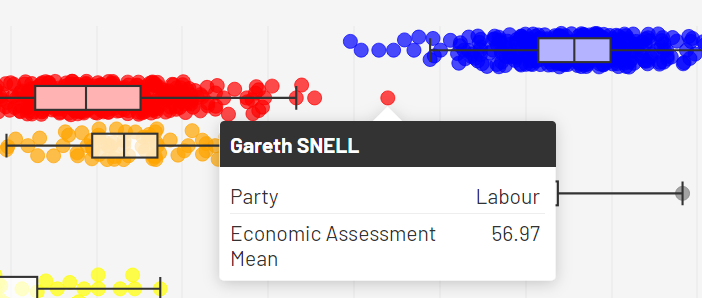Its generally accepted that most Westminster’s Unionist parties – the Conservatives; the Liberal Democrats; and Reform – are right wing. Labour has now reached Center Right position on its march to win over England’s swing voters in marginal seats. So how right wing are they, and how do they compare with national parties, the SNP and Plaid Cymru?
Prof Chris Hanretty and PhD candidate Vasil Lazarov from Royal Holloway, University of London, have completed a study of most Westminster MPs using an assessment of perceived economic ideological position. The assessment was arrived at by polling councillors across England, Wales and Scotland [ref].
614 of Westminster’s 650 MPs were included. The detailed result looks like this when presented in a ‘beeswarm’ chart:
Each dot is an MP. The boxes and lines show quartiles – the middle line in each box is the party median (‘quartiles’ represent different quarters of the data; the ‘median’ is the mid-point of the data).
Using median lines as an indicator and Plaid Cymru’s median as a centre marker, the SNP is to the left of centre and all Westminster Unionist parties are to the right. If you click on the chart you can hover over its elements for more detail.
Let’s look at the parties a little more carefully by comparing their party medians:

Here you can see how MPs from Labour – and even more so the Liberal Democrats – are more right wing in Scotland than England/Wales. The Conservatives don’t change much.
It’s not shown on these charts, but the Unionist party leaders themselves come about mid-way betwee the pairs of points shown for their parties (generally more right wing than the party median itself).
What does this mean for Scotland?
The England-based parties that control Westminster – and hence Scotland – are noticeably to the right of Scotland’s most popular party in our own Parliament, the SNP. Scottish voters strongly prefer Centerist parties.
So why do the MPs from Unionist parties in Scotland appear more rightist in ideology than their party norms?
Explaining the existence of right wing Scottish Labour and Lib Dem MPs
Increasingly Westminster diverges from Scotland’s preferences. As part of the Union there is little that can be done to change this. Or is this expected behaviour?
One possible explanation may be given by May’s special law of curvilinear disparity. This was developed in the 1970s by John D. May [ref]. It argues that rank and file members of a political party tend to be more ideologically extreme than both the leadership of that party and its voters.

In the case of Labour, for example, this means the Labour MPs in Scotland that are more ideologically extreme – as the poll results above suggest. These ‘Middle Elite’ have deeply embedded ideological beliefs. Their primary concern is projecting these on the Party Elite back at HQ in England, as well as the public at large. This is more important even than their electability. In contrast the primary concern of the Party Elite is continued power at Westminster – re-election. To achieve this they are happy to flex their ideological beliefs.
Of course if this theory is to be believed, it suggests that the true ideological beliefs of the Labour and Liberal Democrat MPs are to the right of their campaigning position in the 2024 Westminster election. Now there’s a thought for progressive-minded voters in Scotland.
And what about The SNP in comparison?
May also proposes that the same ‘curvilinear disparity’ exists within Leftist parties. On this basis its quite conceivable that SNP MPs, for example, are more ideologically to the left of the party’s campaigning position.


Leave a Reply